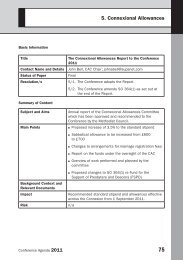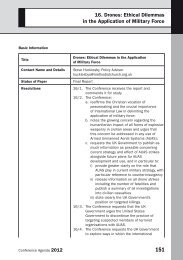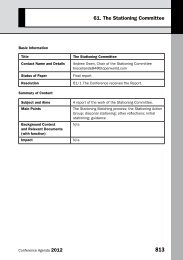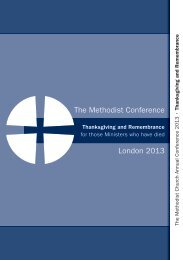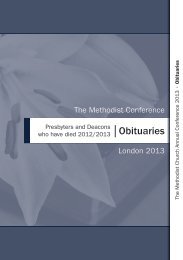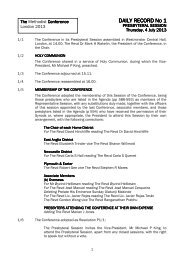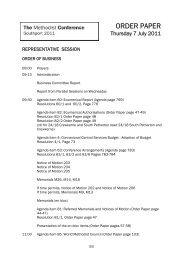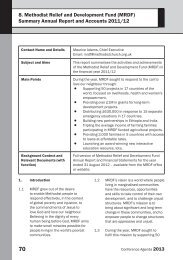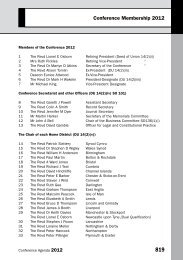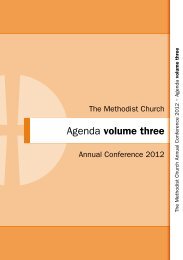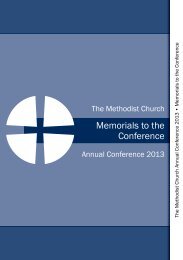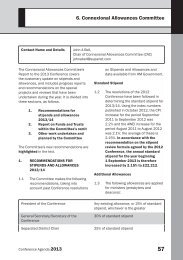Agenda Volume 2 - Methodist Conference
Agenda Volume 2 - Methodist Conference
Agenda Volume 2 - Methodist Conference
Create successful ePaper yourself
Turn your PDF publications into a flip-book with our unique Google optimized e-Paper software.
35. Larger than Circuit<br />
37. Then, whilst it would be a great<br />
exaggeration to suggest that in the<br />
middle of the last century the typical<br />
<strong>Methodist</strong> member was fully aware<br />
of and involved in the life of the<br />
district, a constant theme today is<br />
the sense that our local churches<br />
are increasingly ‘congregational’<br />
in nature, with even the Circuit<br />
being regarded as an unfamiliar,<br />
sometimes intrusive, entity.<br />
38. At the same time growing formal<br />
and informal ecumenical activity,<br />
whether locally or on a wider basis,<br />
has led to natural links being<br />
formed which were unthought-of<br />
in previous generations. In some<br />
parts of the connexion, these are<br />
seen to create groupings which are<br />
more appropriate and effective in<br />
missional terms than the traditional<br />
<strong>Methodist</strong> links.<br />
39. Meanwhile, patterns of leadership<br />
have changed in many ways, not<br />
least the expectation of more<br />
collaborative working, as referred<br />
to above. This is seen in the more<br />
explicit partnership of ordained and<br />
lay ministry in the life of the Church,<br />
for instance through the involvement<br />
of lay people in the stationing<br />
process and the formation of district<br />
leadership teams, and also in the<br />
way that in various districts the<br />
appointment of Co-chairs, or Deputy<br />
or Assistant Chairs, has been found<br />
helpful. A further element is the<br />
increasing use of a mix of people<br />
working on a voluntary and paid<br />
basis (as amplified below).<br />
40. These evolving patterns of leadership<br />
are closely bound up with the<br />
changing nature of the Chair’s role.<br />
Despite the missional emphasis<br />
in the 1950s reports, increasing<br />
demands and expectations have<br />
developed in other directions,<br />
created both by the Church and by<br />
societal changes. The need for the<br />
exercise of proper authority and<br />
oversight has, if anything, increased,<br />
so as to try to ensure responsible<br />
and appropriate conduct by all those<br />
involved in Church life, particularly<br />
where that conduct affects people<br />
(whether in the Church or not) who<br />
are nowadays far more likely to<br />
challenge instances of bad practice<br />
than in the past. But at the same<br />
time there is often an erosion of<br />
respect for authority and a lack of<br />
understanding of the need for such<br />
oversight. As a result, District<br />
Chairs are frequently describing<br />
their role, so far as the district is<br />
concerned, as predominantly one<br />
of ‘fire-fighting’. Alongside these<br />
demands come those arising from<br />
stationing shortages over a number<br />
of years: many so-called separated<br />
Chairs are carrying the responsibility<br />
of superintendency of one or more<br />
circuits for much of the time, whilst<br />
the non-separated Chairs already<br />
serve as Superintendents and have<br />
pastoral charge of local churches.<br />
41. At the same time as having these<br />
different district roles, the Chairs<br />
are connexional leaders, and there<br />
is a more explicit recognition of this<br />
leadership being exercised collegially<br />
<strong>Conference</strong> <strong>Agenda</strong> 2013<br />
377



